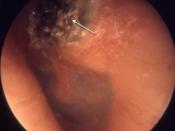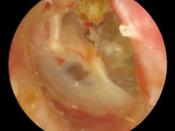In the words of Dr. Mark Levenson, "Cholesteatoma is a serious condition and, when diagnosed, requires prompt treatment." What is cholesteatoma? How can it be treated? Who are likely victims? What are the effects? I chose to find out. Cholesteatoma was the worst-case scenario for me when I had faced years of ear conditions. After being touched by this horrific concept, I decided to educate others on the effects of cholesteatoma and to come to a further understanding of the condition myself.
Let's start from the beginning; what is cholesteatoma? The word cholesteatoma can mean two things to your average doctor. Cholesteatoma can be defined as a serious condition that affects the inner ear, the nerves near the inner ear and sometimes the brain. (Liu, 549) The word cholesteatoma can also be defined as, according to the Dictionary of Medical Syndromes, a non-cancerous tumor that occurs around the eardrum area of the inner ear.
(Magalini, 158) In short, cholesteatoma is a situation where a non-cancerous tumor forms behind the eardrum inside the ear and causes complications. Cholesteatoma is not something to be ignored or left alone. Cholesteatoma actively erodes bone away around the eardrum area and can cause long-term complications. (Levenson, http://www.earsurgery.org/cholest.html)
Cholesteatoma is classified as a rare disease, but that is a common misconception. Cholesteatoma is not rare, but is not commonly found because it is commonly misdiagnosed. Since doctors are unable to see behind the eardrum, it is impossible to diagnose cholesteatoma without a laser microscope or a CAT scan. However, when it is finally diagnosed, it required prompt treatment. (Palacios, 588) Cholesteatoma is not anything to be taken likely, and neither is the treatment. Cholesteatoma can be treated in several ways. Either way, the tumor has to be removed some how. First, if an infection...


